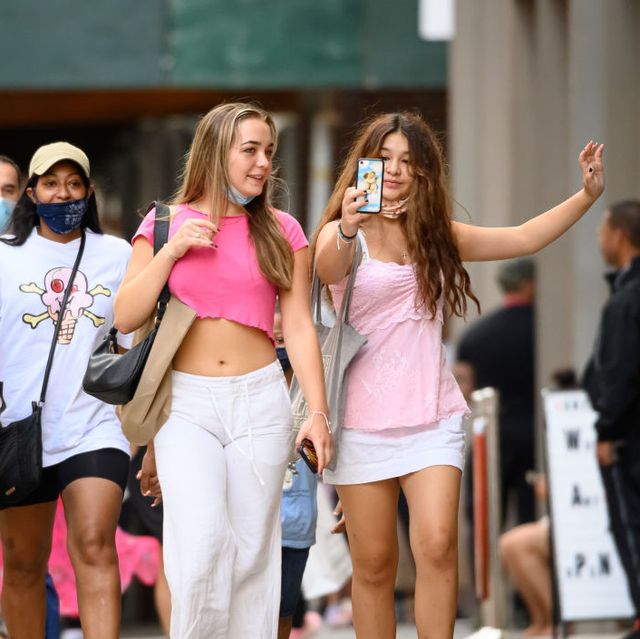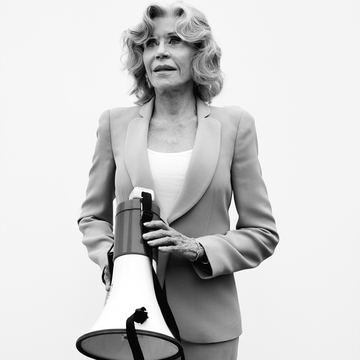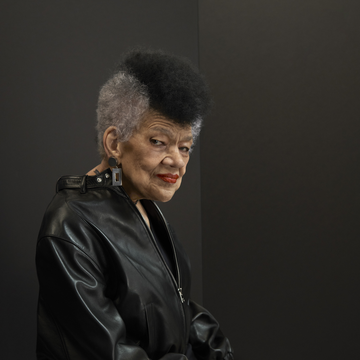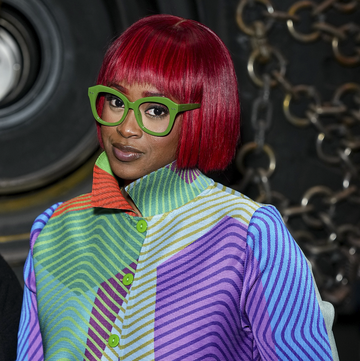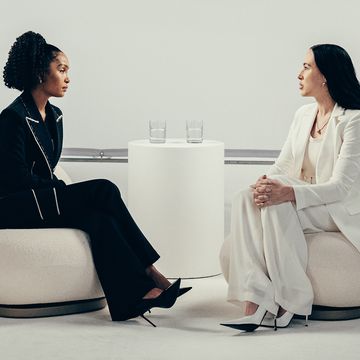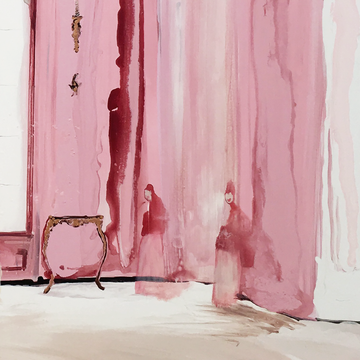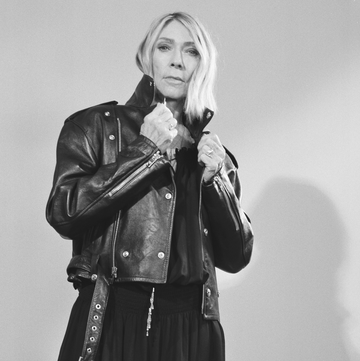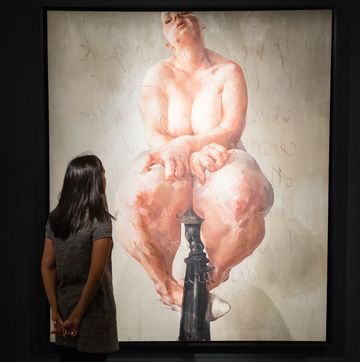A thin, dark-haired girl stands in her bedroom showing off her bloated stomach. A funny audio screams over her video, “You skinny bitches are evil and you need to be destroyed!” Then she transitions to another clip, one where her flat stomach has returned. “And them big fat bitches will burn in hell,” the rest of the sound plays.
The contradictory messages of this post by @supercoollibragirl—which has two million views—are the subject of debate among its more than 4,000 commenters who argue about its intent: Is the young woman humblebragging about her thinness? Or putting herself down for being fat? Some say they love her “confidence” and “y'all are just jealous, she looks great.” Others reassure her that “she’s allowed to have her own insecurities.” Then there’s an overall consensus of wanting “this trend to be buried.”
But what is this trend?
It’s one of the many so-called “body-checking” trends that have plagued social media sites for years and now can be seen on TikTok. Body checking is when users draw attention to the size and shape of their bodies, usually as a way to show off their thinness. In one of the most infamous body-checking trends from 2013, people stood with their knees together to show they were skinny enough to have a “thigh gap.” A decade ago, Tumblr and Instagram became notorious sites riddled with posts that glamorized anorexia and disordered eating. History repeats itself, and old trends have resurfaced to a fresher and naive audience on TikTok with #bodychecking reaching 5.5 million views on the platform.
What is interesting about TikTok’s new wave of body checking is that these videos often try to mask what they’re really about, burying their messages in irony and sly humor. Tonally, it’s very Gen Z, which accounts for 60 percent of TikTok’s users, who are between the ages of 16 and 24.
The problem of social media’s impact on young people’s body image blew up in the news in 2021 with the revelations of the Facebook whistleblower, Frances Haugen, a former product manager for the company. “Thirty-two percent of teen girls said that when they felt bad about their bodies, Instagram made them feel worse,” a leaked presentation slide said. Facebook knew that Instagram was making eating disorders and suicidal ideation worse in teenage girls, Haugen told 60 Minutes.
These revelations confirmed what other researchers had known for years. As far back as 2014, a study conducted by researchers at Florida State University—“Do You ‘Like’ My Photo?” Facebook Use Maintains Eating Disorder Risk—showed the correlation between negative body image and Facebook users. The study reported that adolescent girls who had Facebook accounts were associated with greater “thin-ideal internalization, body surveillance, and drive for thinness.”
“The amount of likes and views being visible is also a huge issue, because it is a quantifiable measure of how your content is liked and approved,” Annalise Mabe, a co-author of the study, now a health writer, says. “And if we continue to post our bodies and ourselves, and wait for others to either approve or disapprove, we’re allowing people to weigh in on our self-worth, based on an image or video.”
Now nearly a decade later, despite all this past research and knowledge, the trend continues. TikTok can be as harmful as other sites in how it encourages body checking, says Indy Atkinson, 21, a TikTok content creator with more than 77,000 followers on her @cometkiddo account, where she tries to warn young women and girls of the negative side of the app.
“There are a lot of videos where people will be body-checking or posting videos where they’re showing their bodies off to get comments saying how skinny they are,” Atkinson says. “That can definitely be harmful, and it does something for their self-esteem … and it encourages them to eat less.”
Atkinson is part of Gen Z, which means she’s spent most of her formative years viewing bodies—her own and others—through the distortion of social media. In 2014, Atkinson had her first encounter with “thinspo,” another term for “thinspiration,” or inspiration for being thin, on Tumblr at the age of 14. She says her feed was flooded with images of perfect bodies, and she sought out how to get hers to look the same way.
“For me, especially, it was kind of the idea of wanting to be clean,” Atkinson says. “Like, if there’s nothing in your stomach, you’re a clean person. I kind of just resorted to being obsessive over body image, because it felt like I had control.”
TikTok has banned the hashtag #thinspo, redirecting users who search it to an eating disorder helpline. However, users have found ways around it, by using code words that enable them to discuss eating disorders and how getting and staying thin can be achieved. Using hashtags. users are able to spread thinspo content without TikTok removing or flagging their accounts. One of the hashtags stands at more than 300,000 views, making it a popular one on the app.
“What I eat in a day” videos are another popular aspect of thinspo culture on TikTok. Some of these videos feature very thin girls eating very little and telling others how they stay thin—often by drinking protein shakes and other drinks instead of eating meals. There are also videos on how to burn extra calories, with unreliable advice such as chewing ice and eating spicy foods as ways to boost the metabolism. Such videos are often flooded with comments in which users offer more unhealthy and unverified tricks for weight loss.
Emerald Dunmore, a 21-year-old TikTok creator with more than 74,000 followers who document her struggles with her ED on her account, @emeralddunmoreart, is very familiar with this type of content on the app. She initially started her account to share her art, but after finding a community of others battling eating issues, she began using her platform as a form of therapy and a way to show others that someone with an ED can come in any shape, size, and race.
She brings up the trend of users recording what they eat while in ED recovery, which could be toxic and ruin people’s relationship with food because of the many critical comments.
“Putting it out there, ‘Oh, even though I'm in recovery, I'm only eating a banana and some bread this morning.’ I feel like those are triggering, I would never ever put calories or anything specific in a video. … When people are like, ‘How do you lose weight?’ I literally don't tell them. I don't specify what I did.”
Most of Dunmore’s videos are comedy based, using a sense of humor to share her trauma with others who can relate. But she does acknowledge that there is a line when it comes to dark humor on the app.
“I think when it comes to specific details, like saying, ‘Oh, haha, I only had 500 calories today,’ I feel like those types of jokes are too far when you're going too deep into detail, because it is a competition. This is a disorder where you're going to be like, ‘I'm going to eat less than you.’ I had to start being mindful of what jokes I made.”
The most distinguishing quality of Gen Z humor is outsiders not understanding it. Gen Z humor works as the perfect cover, because it’s all an inside joke, one only the creator and their followers are able to understand. You’ll find the occasional comments of confusion, asking others to explain, unaware of the inside joke. Through humor, nothing is ever explicitly said; it’s a joke where only avid followers know the punch line, making it harder to regulate, and report.
In a 2019 study published in the scientific journal Body Image, researchers found that using humor as a coping mechanism on social media may result in “cognitive distraction.” According to the study, this reduces the negative impact of being exposed to triggering content surrounding body image on these platforms.
On TikTok, however, the comic bent of body-checking trends is used as a coded way for users to reveal their anorexia and to keep the site from shutting down their accounts. In one video by @daisymerollinup that got more than a million views, the thin girl side-eyes the camera, with overlaid text saying, “How did you lose 75 pounds??? Give us your secrets.”
Users automatically know what she’s alluding to, acknowledging it in the comments: “Literally I just starved,” one comment says; and another, “I don’t work out, I just have an ED.”
The National Association of Anorexia Nervosa and Associated Disorders reports that about 28.8 million Americans will have an eating disorder in their lifetime. For teen girls, suffering from eating disorders may contribute to the number of social media accounts they use, according to a study published by the International Journal of Eating Disorders in 2019. In the study, girls with Snapchat and Tumblr accounts were more likely to suffer from disordered eating behaviors.
Amanda Frothingham, a dietitian in New York City, makes TikTok videos to help teens identify the signs and habits of eating disorders. She also critiques diet culture and gives tips to her more than 62,000 followers on how to have a more normal relationship with food.
Frothingham says she noted the obsession with food and calorie counting on TikTok, and fears that the app is helping to normalize this unhealthy focus. “A lot of times people think, ‘Oh, I’m just obsessed with food,’ or, ‘I just really love eating,’ or, ‘I’m just really obsessed with being healthy,’” she says. “And it’s when that obsession takes over their life that it becomes more disordered than just a healthy habit.”
Besides following TikTok accounts like Frothingham’s to be more informed, users can also try diversifying their feeds and actively change their own algorithms to avoid seeing content that could trigger them.
“I will try to actively engage in content that does not have bodies or faces in it,” Mabe suggests. “Maybe like peaceful scenes or quotes, or pictures of cute cats or animals, because I really want to balance the content that’s being delivered to me.”
Those suffering from an eating disorder and other issues related to negative body image can find support from the National Eating Disorders helpline at 1-800-931-2237.
Breona Couloote is a New York-based writer and video producer interested in mental health.
